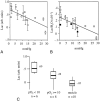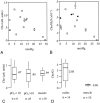In vivo 1H MR spectroscopy of human head and neck lymph node metastasis and comparison with oxygen tension measurements
- PMID: 10669248
- PMCID: PMC7976356
In vivo 1H MR spectroscopy of human head and neck lymph node metastasis and comparison with oxygen tension measurements
Abstract
Background and purpose: Current diagnostic methods for head and neck metastasis are limited for monitoring recurrence and assessing oxygenation. 1H MR spectroscopy (1H MRS) provides a noninvasive means of determining the chemical composition of tissue and thus has a unique potential as a method for localizing and characterizing cancer. The purposes of this investigation were to measure 1H spectral intensities of total choline (Cho), creatine (Cr), and lactate (Lac) in vivo in human lymph node metastases of head and neck cancer for comparison with normal muscle tissue and to examine relationships between metabolite signal intensities and tissue oxygenation status.
Methods: Volume-localized Lac-edited MRS at 1.5 T was performed in vivo on the lymph node metastases of 14 patients whose conditions were untreated and who had primary occurrences of squamous cell carcinoma. MRS measurements were acquired also from the neck muscle tissue of six healthy volunteers and a subset of the patients. Peak areas of Cho, Cr, and Lac were calculated. Tissue oxygenation (pO2) within the abnormal lymph nodes was measured independently using an Eppendorf polarographic oxygen electrode.
Results: Cho:Cr ratios were significantly higher in the nodes than in muscle tissue (node Cho:Cr = 2.9 +/- 1.6, muscle Cho:Cr = 0.55 +/- 0.21, P = .0006). Lac was significantly higher in cancer tissue than in muscle (P = .01) and, in the nodes, showed a moderately negative correlation with median pO2 (r = -.76) over a range of approximately 0 to 30 mm Hg. Nodes with oxygenation values less than 10 mm Hg had approximately twice the Lac signal intensity as did nodes with oxygenation values greater than 10 mm Hg (P = .01). Cho signal intensity was not well correlated with pO2 (r = -.46) but seemed to decrease at higher oxygenation levels (>20 mm Hg).
Conclusion: 1H MRS may be useful for differentiating metastatic head and neck cancer from normal muscular tissue and may allow for the possibility of assessing oxygenation. Potential clinical applications include the staging and monitoring of treatment.
Figures







Similar articles
-
In vivo 1H magnetic resonance spectroscopy of lactate in patients with stage IV head and neck squamous cell carcinoma.Int J Radiat Oncol Biol Phys. 2008 Jul 15;71(4):1151-7. doi: 10.1016/j.ijrobp.2007.11.030. Epub 2008 Feb 6. Int J Radiat Oncol Biol Phys. 2008. PMID: 18258377 Free PMC article.
-
Proton MR spectroscopy of squamous cell carcinoma of the extracranial head and neck: in vitro and in vivo studies.AJNR Am J Neuroradiol. 1997 Jun-Jul;18(6):1057-72. AJNR Am J Neuroradiol. 1997. PMID: 9194433 Free PMC article.
-
Oxygenation of squamous cell carcinoma of the head and neck: comparison of primary tumors, neck node metastases, and normal tissue.Int J Radiat Oncol Biol Phys. 1998 Aug 1;42(1):35-41. doi: 10.1016/s0360-3016(98)00182-5. Int J Radiat Oncol Biol Phys. 1998. PMID: 9747817
-
Magnetic resonance spectroscopy of head and neck neoplasms.Top Magn Reson Imaging. 2004 Apr;15(2):87-94. doi: 10.1097/01.rmr.0000130599.19502.ba. Top Magn Reson Imaging. 2004. PMID: 15269611 Review.
-
Imaging of nodal metastases in the head and neck.J Magn Reson Imaging. 1997 Sep-Oct;7(5):774-83. doi: 10.1002/jmri.1880070503. J Magn Reson Imaging. 1997. PMID: 9307901 Review.
Cited by
-
Differentiation of Benign and Malignant Neck Neoplastic Lesions Using Diffusion-Weighted Magnetic Resonance Imaging.J Imaging. 2024 Oct 18;10(10):257. doi: 10.3390/jimaging10100257. J Imaging. 2024. PMID: 39452420 Free PMC article.
-
Oxygen Imaging for Non-Invasive Metastasis Detection.Sensors (Basel). 2021 Dec 29;22(1):237. doi: 10.3390/s22010237. Sensors (Basel). 2021. PMID: 35009780 Free PMC article.
-
Zinc coordination is required for and regulates transcription activation by Epstein-Barr nuclear antigen 1.PLoS Pathog. 2009 Jun;5(6):e1000469. doi: 10.1371/journal.ppat.1000469. Epub 2009 Jun 12. PLoS Pathog. 2009. PMID: 19521517 Free PMC article.
-
[(18)F]FMISO and [(18)F]FDG PET imaging in soft tissue sarcomas: correlation of hypoxia, metabolism and VEGF expression.Eur J Nucl Med Mol Imaging. 2003 May;30(5):695-704. doi: 10.1007/s00259-002-1096-7. Epub 2003 Mar 11. Eur J Nucl Med Mol Imaging. 2003. PMID: 12632200 Clinical Trial.
-
Can magnetic resonance spectroscopy differentiate malignant and benign causes of lymphadenopathy? An in-vitro approach.PLoS One. 2017 Aug 8;12(8):e0182169. doi: 10.1371/journal.pone.0182169. eCollection 2017. PLoS One. 2017. PMID: 28792506 Free PMC article.
References
-
- Evanochko WT, Sakai TT, Ng TC, et al. NMR study of in vivo RIF-1 tumors: analysis of perchloric acid extracts and identification of 1H, 31P and 13C resonances. Biochim Biophys Acta 1984;805:104-116 - PubMed
-
- Langkowski JH, Wieland J, Bomsdorf H, et al. Pre-operative localized in vivo proton spectroscopy in cerebral tumors at 4.0 tesla: first results. Magn Reson Imaging 1989;7:547-555 - PubMed
-
- Alger JR, Frank JA, Bizzi A, et al. Metabolism of human glio-mas: assessment with H-1 MR spectroscopy and F-18 fluorodeoxyglucose PET (comment). Radiology 1990;177:633-641 - PubMed
-
- Bruhn H, Frahm J, Gyngell ML, et al. Noninvasive differentiation of tumors with use of localized H-1 MR spectroscopy in vivo: initial experience in patients with cerebral tumors. Radiology 1989;172:541-548 - PubMed
-
- Arnold DL, Shoubridge EA, Villemure JG, Feindel W. Proton and phosphorus magnetic resonance spectroscopy of human astrocytomas in vivo: preliminary observations on tumor grading. NMR Biomed 1990;3:184-189 - PubMed
Publication types
MeSH terms
Substances
Grants and funding
LinkOut - more resources
Full Text Sources
Medical
